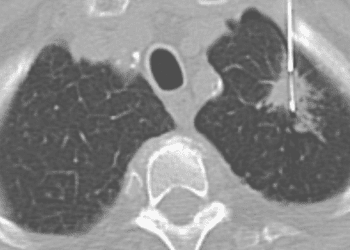Safety and Efficacy of Femoral Access vs Radial Access in ST-Segment Elevation Myocardial Infarction
1. There is no significant difference in 30-day all-cause mortality between radial and femoral access for percutaneous coronary intervention (PCI) following ST-segment elevation myocardial infarction (STEMI).
Evidence Rating Level: 1 (Excellent)
Primary percutaneous coronary intervention (PCI) is the standard of care for achieving reperfusion in patients with ST-segment elevation myocardial infarction (STEMI). However, the procedure is not without substantial risk, mostly related to exposure to potent antiplatelet and anticoagulant therapies. Radial access is gaining popularity based on studies demonstrating a better safety profile than femoral access, and two recent trials have suggested that radial access is associated with lower mortality after PCI. However, this finding remains a topic of debate. In this randomized controlled trial, 2,292 patients with STEMI referred for primary PCI were assigned to either radial access or femoral access to study the primary outcome of 30-day all-cause mortality. The baseline characteristics of the two study groups were equivalent. In terms of medications and procedural choices, all patients were administered a loading dose of a P2Y12 platelet inhibitor before cardiac catheterization. During PCI, bivalirudin was used in 88.1% of patients in the radial access group and 92.4% of the patients in the femoral access group. The median interval between administration of lidocaine and balloon inflation/device was 2 minutes longer in the radial access group (radial median 13 minutes, IQR 10 to 17 minutes; femoral median 11 minutes, IQR 9 to 14 minutes; p<0.001). Furthermore, the median (IQR) fluoroscopy time was also significantly longer in the radial access group than in the femoral access group (9.4 minutes, 6.5 to 13.5 vs. 8.2 minutes, 6.0 to 12.5, p<0.001). Ultimately, the trial was terminated early due to a lower-than-expected rate of the primary outcome. At study termination, researchers found that there was no significant difference in all-cause 30-day mortality between the two groups (radial access: 1.5%; femoral access: 1.3%; RR 1.15, 95% CI 0.58 to 2.30, p=0.69). Moreover, there were no significant differences in any of the secondary outcomes, including stroke, reinfarction, stent thrombosis, and bleeding within 30 days. Limitations of this study include the exclusion of patients treated with fibrinolytic therapy and patients prescribed oral anticoagulants. Overall, this study suggests that there is no survival benefit of using radial access for primary PCI, but further studies are required to confirm this finding given the premature termination of the trial.
Click to read the study in JAMA Cardiology
Image: PD
©2020 2 Minute Medicine, Inc. All rights reserved. No works may be reproduced without expressed written consent from 2 Minute Medicine, Inc. Inquire about licensing here. No article should be construed as medical advice and is not intended as such by the authors or by 2 Minute Medicine, Inc.







